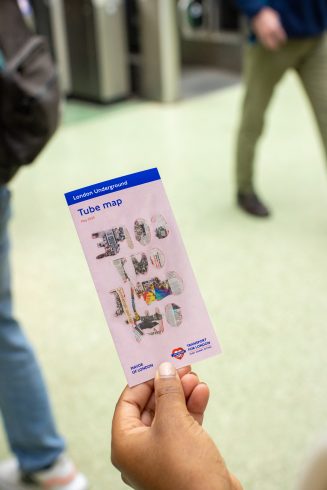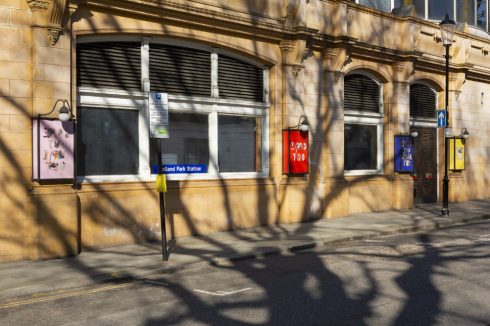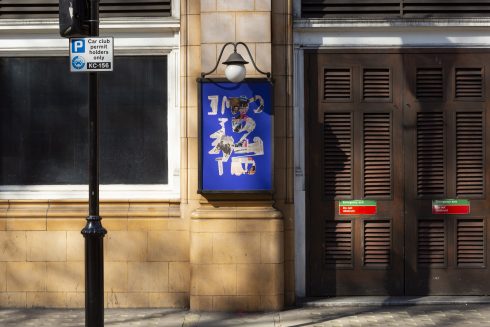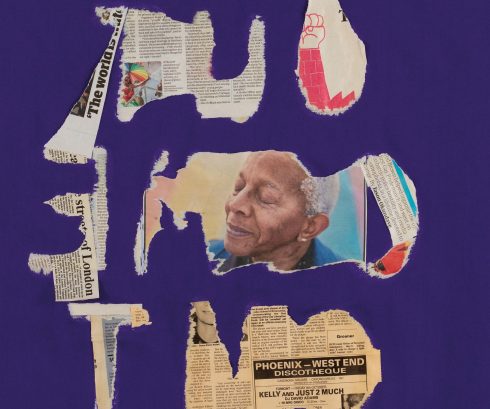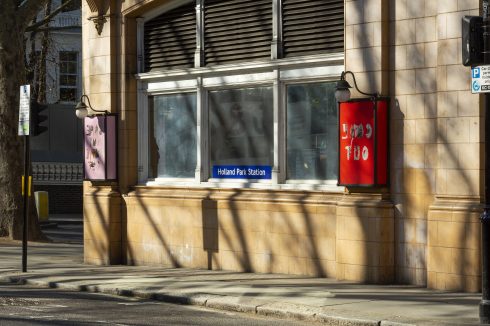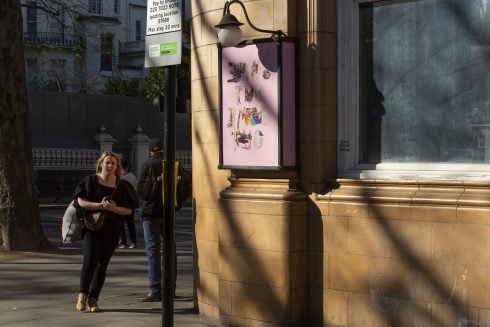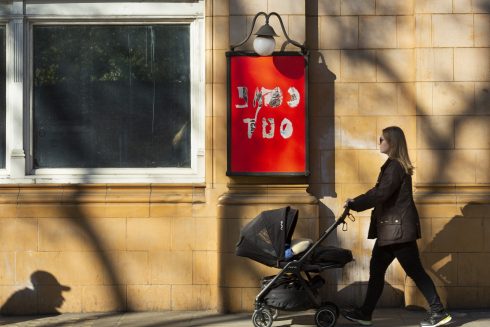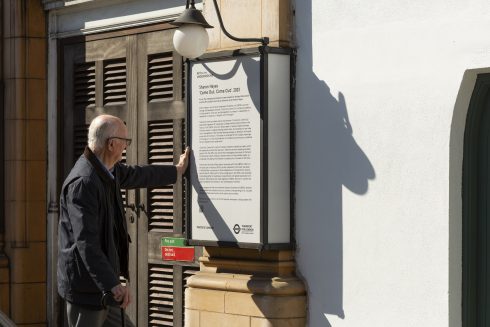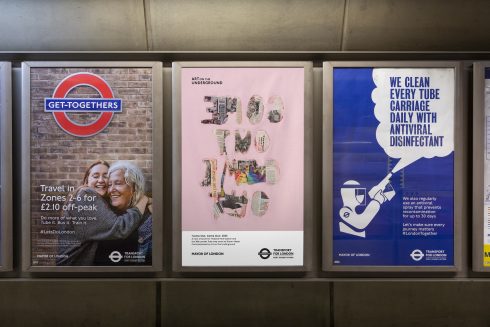Art on the Underground presents a new artwork for Holland Park station and the 38th pocket Tube map by American artist Sharon Hayes.
Sharon Hayes’s new artwork celebrates the history of LGBTQ+ activism through UK newspaper archives. ‘Come Out, Come Out’, Hayes new artwork invites its audience to hold space to ‘come out’ and be together, in protest, in celebration, in resistance, in solidarity, in fragility and in strength.
Hayes uses video, performance, sound, public sculpture, and textiles to disentangle prevailing histories and examine the intersections between time, politics, and speech. Hayes’s multidisciplinary practice engages with feminist history, LGBTQ+ genealogies and the transformative power of language.
Inspired by historic protest events and banners, ‘Come Out, Come Out’ assembles fragments of newspaper cuttings marking major events in the history of UK LGBTQ+ activism. Using the back of a fabric banner as a platform for an improvisational collage, the backward slogans, ‘Come Out, Come Out’ and ‘Come Out’, reflect on the dynamic temporalities of activism and its distribution into the public sphere. Hayes’s work for the pocket Tube map cover is extended at Holland Park Tube station to include four additional artworks which alternate between the slogans and vibrant colour backgrounds along the exterior of the station.
Always seen in reverse, Hayes’s artwork banners invites the viewer to imagine being stood behind them, as though the banners are being held up or seen in a rear-view mirror, a reflection of the past as we look to the future. The legibility of the reversed lettering emerges gradually, allowing for a slower consideration of the words and their meanings. As the words come into view, the viewer is reminded of the multiple meanings of ‘coming out’ – an act of self-identity, an invitation to community, a collective force of resistance and celebration.
‘Come Out, Come Out’ is part of a series of banners created by Hayes, which are inspired by an encounter she had in a feminist archive. Handling a protest banner from the 1970s, she noticed that newspapers had stuck to the back of the banner’s fabric created a reverse imprint of the painted slogan, an accidental time stamp of the banner’s creation and the news of that time. This process has been replicated in this new work for the Pocket Tube map.
Hayes is interested in the power of language and its differing visual, sonic and emotional registers as it is disseminated and re-disseminated across time and space. The phrase ‘come out’ was first used by the LGBTQ+ community in the 1950s in reference to ‘coming out’ into gay society, self-disclosing one’s sexuality or gender identity. It has since been used more widely by LGBTQ+ communities and other social justice movements to communicate and celebrate self-identity as a means of galvanising solidarity and support and reducing isolation.
The newspaper cuttings that appear in the artwork include: a profile of Black gay activist Ted Brown, former member of the Gay Liberation Front who co-organised a gay ‘kiss-in’ at the first official Pride march in London in 1972, historic articles on ‘stop the clause’ protests against the section 28, a law enacted in 1988 and repealed in 2000/03, preventing any UK school or local authority from making positive statements about same-sex relationships, profiles of the past 50 years of Pride in London, celebrations of Black LGBTQ+ history and a story about LGBT Syrian refugees celebrating their first pride in London in 2021. Using collage to de-frame and reframe historical moments of LGBTQ+ activism, Hayes reveals how resistance and our common understandings of it, circulate through intimate reencounters, both radical and mundane.
The artwork at Holland Park Tube station resonates with the LGBTQ+ history of the local area. In the early 1970s, the Gay Liberation Front held ‘Gay Days’ in Holland Park, a precursor to Pride celebrations. Across the road from the station, 27 Holland Park Avenue was the site of ‘Lady Austin’s’ famous drag balls in the 1930s, where people could safely gather to celebrate and experiment with gender expression and sexuality. The gatherings were hosted by the ostentatious Lady Austin, a 24-year-old barman called John P. Information about the events was spread with flyers through a network of hospitality employees across London. In 1932, one ball was subject to a police raid and the organisers were sentenced to imprisonment. Upon being arrested, Lady Austin reportedly asked, ‘What harm are we doing? You don’t understand our love’. These events and other legacies of LGBTQ+ activism in London are vital to preserve and maintain in our contemporary moment.
Through ‘Come Out, Come Out’, Hayes explores the historical registers of language and is a timely reminder that holding space to come out – in resistance and in joy – is our most powerful collective act.
Eleanor Pinfield, Head of Art on the Underground, said: “Sharon Hayes’s Pocket Tube map commission is breaking new ground centring LGBTQ+ protest movement on the cover of the Tube map. Her reversed slogan, ‘Come Out, Come Out’, brings us all to stand, metaphorically, behind this banner. With the expanded display of works at Holland Park Tube station, we can reflect on Hayes’s practice exploring archives, language and protest. As this map comes out in the hands of millions of people in London, we share in this proud history of the city and come together as one community.”
Justine Simons OBE, Deputy Mayor for Culture and Creative Industries, said: “This is a powerful reminder of the history of our LGBTQI+ communities and it is poignant that Sharon Hayes’s work will feature at Holland Park, where so much of that history took place. I am pleased that this significant art work will also feature on the pocket Tube map, giving commuters the chance to reflect on this important story. Art on the Underground is renowned for transforming the network into the world’s biggest art gallery and is a great example of how we are building a better and fairer London for everyone.”

